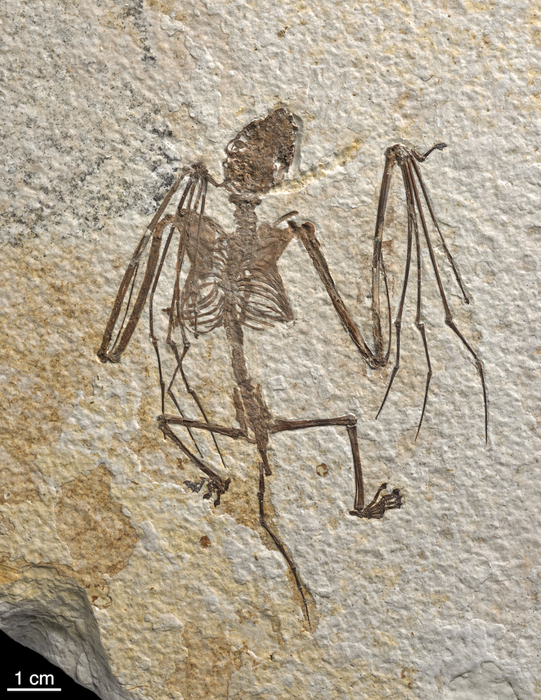Scientists have described a new species of bat based on the oldest bat skeletons ever recovered. The study on the extinct bat, which lived in Wyoming about 52 million years ago, supports the idea that bats diversified rapidly on multiple continents during this time. Led by researchers at the American Museum of Natural History and Naturalis Biodiversity Center in the Netherlands, the study is published today in the journal PLOS ONE.
There are more than 1,460 living species of bats found in nearly every part of the world, with the exception of the polar regions and a few remote islands. In the Green River Formation of Wyoming—a remarkable fossil deposit from the early Eocene—scientists have uncovered over 30 bat fossils in the last 60 years, but until now they were all thought represent the same two species.
“Eocene bats have been known from the Green River Formation since the 1960s. But interestingly, most specimens that have come out of that formation were identified as representing a single species, Icaronycteris index, up until about 20 years ago, when a second bat species belonging to another genus was discovered,” said study co-author Nancy Simmons, curator-in-charge of the Museum’s Department of Mammalogy, who helped describe that second species in 2008. “I always suspected that there must be even more species there.”
In recent years, scientists from the Naturalis Biodiversity Center started looking closely at Icaronycteris index by collecting measurements and other data from museum specimens.
“Paleontologists have collected so many bats that have been identified as Icaronycteris index, and we wondered if there were actually multiple species among these specimens,” said Tim Rietbergen, an evolutionary biologist at Naturalis. “Then we learned about a new skeleton that diverted our attention.”
The exceptionally well-preserved skeleton was collected by a private collector in 2017 and purchased by the Museum. When researchers compared the fossil to Rietbergen’s expansive dataset, it clearly stood out as a new species. A second fossil skeleton discovered in the same quarry in 1994 and in the collections of the Royal Ontario Museum was also identified as this new species. The researchers gave these fossils the species name Icaronycteris gunnelli in honor of Gregg Gunnell, a Duke University paleontologist who died in 2017 and made extensive contributions to the understanding of fossil bats and evolution.
Although there are fossil bat teeth from Asia that are slightly older, the two I. gunnelli fossils represent the oldest bat skeletons ever found.
“The Fossil Lake deposits of the Green River Formation are simply amazing because the conditions that created the paper-thin limestone layers also preserved nearly everything that settled to the lake’s bottom,” said Arvid Aase, park manager and curator at the Fossil Butte National Monument, in Wyoming. “One of these bat specimens was found lower in the section than all other bats, making this species older than any of the other bat species recovered from this deposit.”
While the I. gunnelli skeletons are the oldest bat fossils from this site, they are not the most primitive, supporting the idea that Green River bats evolved separately from other Eocene bats around the world.
“This is a step forward in understanding what happened in terms of evolution and diversity back in the early days of bats,” Simmons said.
ABOUT THE AMERICAN MUSEUM OF NATURAL HISTORY (AMNH)
The American Museum of Natural History, founded in 1869 to advance research in science and education, is one of the world’s preeminent scientific, educational, and cultural institutions. The Museum encompasses more than 40 permanent exhibition halls, galleries for temporary exhibitions, the Rose Center for Earth and Space including the Hayden Planetarium, and the Richard Gilder Center for Science, Education, and Innovation, opening May 4. The Museum’s scientists draw on a world-class permanent collection of more than 34 million specimens and artifacts, some of which are billions of years old, and on one of the largest natural history libraries in the world. Through its Richard Gilder Graduate School, the Museum offers two of the only free-standing, degree-granting programs of their kind at any museum in the U.S.: the Ph.D. program in Comparative Biology and the Master of Arts in Teaching (MAT) Earth Science residency program, whose graduates make up approximately half of New York City’s certified Earth Science teachers. Visit amnh.org for more information.
